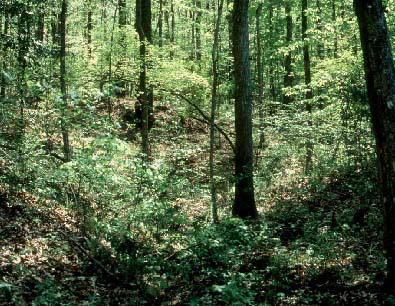
The white-tailed deer has a certain requirement for cover. Cover provides a sense of security from disturbance and protection from inclement weather and predators. The amount and kind of cover vary somewhat throughout the country.
A stand of herbaceous plants may provide adequate cover for deer in open, grassland country, even though deer prefer woody cover (trees and shrubs). The best cover for a large species such as white-tailed deer is a pattern or mosaic of woody brush and trees interspersed within open areas at an approximate 2/1 ratio of open area to woody cover. Clumps or strips of brush should be wide enough so that a person cannot see through them from one side to the other during the winter months when deciduous species are bare of leaves. Cover strips should be as continuous as possible to provide travel lanes. A habitat that provides several different types and arrays of cover benefits more species of wildlife than a habitat that has limited types, amounts, and distribution of cover.
Management of vegetation, whether it be deciduous woodlands, coniferous woodlands, mesquite woods, or open grasslands, requires long-term planning. Any vegetation manipulation practice will have an impact on resident wildlife species, either good or bad, depending on the type of treatment used, the degree of use, and location. Before implementing vegetation control techniques, determine what the long-term effects will be for deer and other wildlife species that occur in the area and minimize the negative impacts. Consider the location and size of sensitive wildlife habitats that provide important nesting or roosting sites, feeding areas, desirable wildlife food producing plants, cover, water, and space needs.
Wildlife can be displaced by disturbance from an area without adequate escape or security cover. The amount and distribution of cover on adjacent lands need to be taken into consideration when assessing the cover needs of wide-ranging wildlife species such as deer and turkey. A small ranch would need a larger amount of security cover on a percentage basis than would a larger ranch where the vastness of the area provides security. The need for security cover is not as great for a deer herd that is enclosed by a high fence since the fence prevents deer from moving to areas with denser cover to avoid disturbances.
Typically, increased predator control is allowed on high-fenced properties as well. However, having suitable cover available for an enclosed deer herd to retreat into when disturbed is highly recommended, and may keep the animals calmer and less stressed, and ultimately more productive.

Very good article, and a very comprehensive blog. Great work!